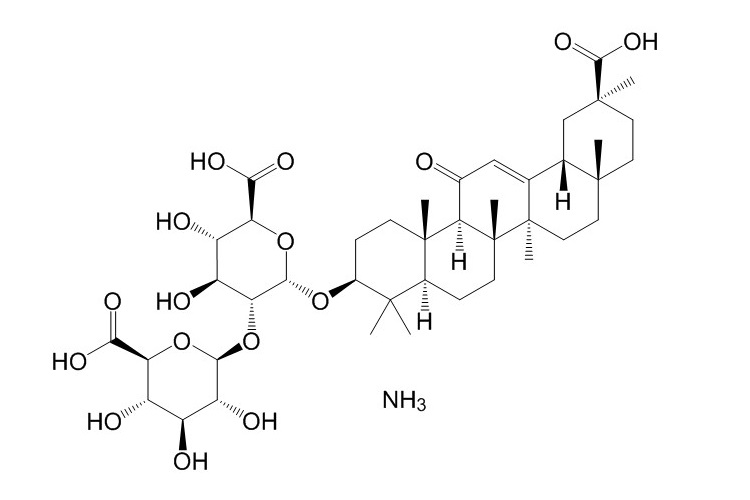Home
Products
Glycyrrhizic acid ammonium salt



| Product Name | Glycyrrhizic acid ammonium salt |
| Price: | $37 / 20mg |
| Catalog No.: | CN08115 |
| CAS No.: | 53956-04-0 |
| Molecular Formula: | C42H65NO16 |
| Molecular Weight: | 839.96 g/mol |
| Purity: | >=98% |
| Type of Compound: | Triterpenoids |
| Physical Desc.: | White powder |
| Source: | The roots of Glycyrrhiza glabra L. |
| Solvent: | DMSO, Pyridine, Methanol, Ethanol, etc. |
| SMILES: | O[C@@H]1[C@@H](O[C@@H]2O[C@H](C(=O)[O-])[C@H]([C@@H]([C@H]2O)O)O)[C@H](O[C@@H]([C@H]1O)C(=O)[O-])O[C@H]1CC[C@]2([C@H](C1(C)C)CC[C@@]1([C@@H]2C(=O)C=C2[C@@]1(C)CC[C@@]1([C@H]2C[C@](C)(CC1)C(=O)[O-])C)C)C.[NH4+].[NH4+].[NH4+] |
| Contact us | |
|---|---|
| First Name: | |
| Last Name: | |
| E-mail: | |
| Question: | |
| Description | Monoammonium glycyrrhizinate hydrate has various pharmacological actions such as anti-inflammatory, antiallergic, antigastriculcer, and antihepatitis activities. |
| In Vivo | The increase of the lung W/D weight ratios is significantly reduced by high and medium dose of MAG (10 and 30mg/kg) administration. Pretreatment with MAG (10 and 30mg/kg) efficiently reduces the production of TNF-α and IL-1β. MAG (10, 30mg/kg) significantly decreases NF-κB p65 protein expression, compared with LPS. On the contrary, LPS significantly reduces IκB-α protein expression compared with the control group, whereas MAG (10 and 30mg/kg) significantly increased IκB-α expression, compared with the LPS group[1]. Low- and high-dose MAG treatment significantly reduces the AST, ALT, TBIL, and TBA levels at 14 and 21 d time points when compared with that of the RIF and INH group, suggesting the protective effect of MAG on RIF- and INH-induced liver injury. MAG treatment groups elevate the hepatic GSH level at 7, 14, and 21 d time points and markedly reduce the MDA level at 14 and 21 d time points in RIF- and INH-treated rats, suggesting the protective effect of MAG in RIF- and INH induced liver injuries[2]. |
| Animal Admin | Mice[1] In this study, BALB/c mice (male, 6-8weeks old, and 20-25 g) are used. Mice are randomly divided into five groups: control group, LPS group, and LPS + Monoammonium glycyrrhizinate (MAG: 3, 10, and 30mg/kg) groups. Each group contains eight mice. Mice are anesthetized with intraperitoneal injection of sodium pentobarbital (50mg/kg). Before inducing acute lung injury, the mice are given intraperitoneal injection with MAG (3, 10, and 30mg/kg). One hour later, LPS (5mg/kg) is instilled intratracheally to induce acute lung injury. Normal mice are given PBS[1]. Rats[2] Male Wistar rats (180-220 g) are used. Rats are randomly divided into four groups, i.e., control group, RIF and INH group, MAG low-dose group, and MAG high-dose group, each group has 15 rats. Rats in the RIF and INH group receive RIF (60 mg/kg) and INH (60 mg/kg) by gavage administration once daily; rats in MAG groups are pretreated with MAG at the doses of 45 or 90 mg/kg, RIF (60 mg/kg) and INH (60 mg/kg) are given 3 h after MAG administration; rats in the control group are treated with saline. To evaluate the dynamic effect of drugs, rats in each group are sacrificed on 7, 14, and 21 d after drug administration[2]. |
| Density | 1.43g/cm3 |
| Boiling Point | 971.4ºC at 760mmHg |
| Flash Point | 288.1ºC |
| PSA | 272.70000 |
| LogP | 0.32860 |
| Storage condition | 2-8°C |